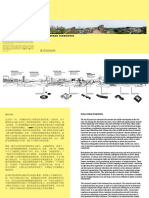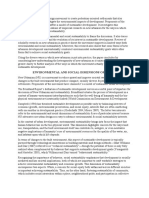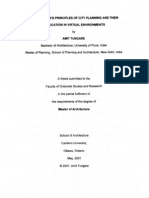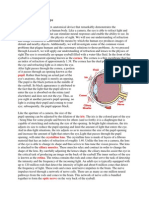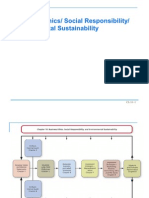The Emotional City
The Emotional City
Uploaded by
Guido GrecoCopyright:
Available Formats
The Emotional City
The Emotional City
Uploaded by
Guido GrecoOriginal Description:
Copyright
Available Formats
Share this document
Did you find this document useful?
Is this content inappropriate?
Copyright:
Available Formats
The Emotional City
The Emotional City
Uploaded by
Guido GrecoCopyright:
Available Formats
The Emotional City
significant role in the city's development how can architecture continue to operate in
Adam Caruso
Many cities do have physical structures that originate from a priori ideas; from a
Quaderns (Barcelona, Spain: January 2001) Issue 228, pp.813
Roman military encampment, from an amazing nineteenth century gridded extension,
good faith?
or from Jefferson's demarcation of the American territory. In the nineteenth and
The urban environment is a precise emotional condition. Being in the city feels a
beginning of the twentieth century, networks of squares and parks, the replacement of
certain way. This is similar to being at home, you know when you feel at home, when
city walls with Boulevards are also the result of abstract political ideas put into
you can take your shoes off and relax. This feeling of being at home can be
practice. Very quickly, however, an incredibly complex set of conditions are brought to
communicated to other people even though they live in different kinds of homes.
bear onto these ideological origins, and each city develops in subtly different ways.
Similarly, the feeling of being in the city is not easily confused with being in a shopping
Weather, geology and topography have an effect, as do changing patterns of land
mall, or being in a theme park, and most people are sensitive to these differences.
ownership. Law in the widest sense, has a powerful effect. As these many, changing
The architectural vanguard has not recently much discussed the significance, or the
forces assert themselves, each city, or each part of large cities, assumes its own
defining characteristics of homeyness. At the turn of the century, the propriety of the
morphology. Each city has its own size and configuration of block, has its own version
home was a central theme in the discourses of architects like Semper and Loos, who
of a city house typology, its own way of making a facade. In Europe the longevity of
tried to articulate what was the difference between a house and a public building. The
this process means that cities have become important physical repositories of a
city, on the other hand, has been hotly debated by all manner of architects and
place's history, but even more powerfully the city is a manifestation of a particular
urbanists, arguing positions which range from the reconstruction of the European city
living culture, of reality.
to a new fluid functionalism which emerges from global market forces. It is strange
that so much is said and predicted for the future of the city since all evidence suggests
I am holding up a very traditional idea of the city to be a paradigm. I am not, however,
that physical planning plays a barely significant role in the development of cities. The
especially interested in the conservation of this paradigms physical structure. I am
growing pressures to concentrate use, to assemble ever larger sites, to erode the
concerned that instead of discussing theories of the future city there be a discussion
public realm are driven by economic development, and architects are usually left to
about how the form of the real city has emerged and why, in Europe at least, the city
interpret and facilitate decisions that have been taken at a much earlier stage of the
continues to be relevant, robustly adapting to hundreds of years of political and
process, decisions that architects and planners are rarely party to. Cities are in fact
economic change and also resisting being turned into a large open air museum. While
highly resistant to a priori ideologies and instead follow a continuous and barely
one might intuitively be suspicious of the romantic variety and finely grained scale that
perceptible form of structural development. A development that is an embodiment of
now make the historic centres of our cities such popular tourist attractions, this
culture, of peoples ambitions and desires. Thought of this way, rather than being an
consistent heterogeneity eloquently registers the mixed tenure and density of
imperfect manifestation of an abstract theory, the city is a perfect and vivid instance of
ownership and use so characteristic of and necessary to a liberal and democratic
reality. If one accepts that abstract, formal ambitions will almost never play a
society. Hundreds of separate interests fronting onto a single street, all more or less
subscribing to certain rules of engagement and benefiting from a multiplicity of social
and economic transactions. Within obvious limits, all the inhabitants of a street are
Rather than attempting to conceptualise the whole of urbanism, a critical architecture
empowered to make choices and to effect change.
can emerge by ignoring the big and the general and work with the minute and the
highly specific. Architecture should be sensitive to those emotional qualities that
Contrast this with land assembly, one of the most direct and destructive
define the city, melancholy, expectancy, pathos, hope. If one accepts that architecture
manifestations of the current economic regime on the city. The requirement to
is about altering and extending what is already there, one can engage the powerful
increase returns on investment year on year means that even profitable properties
presence of the real so that the aura of urbanity is amplified and extended in the place
need to earn more. This can only be achieved by demolishing single buildings and
that one is working. The complexity and interconnectedness of the city is sustained by
erecting ever larger, more efficient ones. When efficiency can no longer be improved,
such instances of profound invention.
buildings are still replaced in favour of newer, fresher packages that can tempt tenants
away from buildings that are sometimes themselves only a few years old. This is a
London
vicious circle with devastating environmental implications. While planning authorities
may argue about facade materials and the survival of medieval street patterns in the
London, despite its size, its tradition of compromise and an English cultural
master plan, several city blocks, that once housed thousands of tenants and was in
ambivalence towards urbanity, is a great and moving city. A city so large that there still
the ownership of hundreds, is now controlled by one owner backed by international
exist substantial parts that have resisted the ravages of land speculation and have
financial institutions. Do not be fooled by the medieval street pattern, the well
continued to develop and adapt in response to a multiplicity of conditions rather that to
maintained squares, the lunch time activities, these developments constitute a serious
unitary special interests. It retains a loose, sometimes toothless texture that is still
erosion of democracy and of the public realm. This process is taking place all over
emphatically urban. London is so decentralised that one can live and work within
London and in all major cities. Far from attempting to control this serious threat to the
walking distance in the east end and only visit west London every month or two, for a
health of cities, politicians and planning authorities encourage these developments as
sort of holiday without leaving the city.
regeneration essential if cities are to maintain their status as economic centres.
The pathetic failures to plan London somehow proclaim a triumph of human frailty and
I am not arguing for a return to some mythical past or for protecting the status quo, but
reality over abstract theories. The imperfections and incompleteness of its many
in sustaining the condition of heterogeneity which I believe to be fundamental to the
utopian fragments (the Georgian city, garden city, ville radieuse, new vernacular) is a
city. The current fashion for discussing the future of cities, and how their structure will
poignant indication of how urbanism follows strong internal forces that are not easily
emerge from the global market and new information technologies is as futile as the
described. The resulting complexity and never-ending potential of the city has little to
modernist discourses of the twentieth century. These ideologies are about shock and
do with novelty and theoretical abstraction but is held within the deeply moving world
novelty, they define themselves in contrast to what exists. They confront the vivid
of things.
plurality of the real city with the deadening unity of an ideal city, an ideal which will
always be insufficient, incomplete and disappointing in the face of an infinitely
complex reality.
You might also like
- Thematic TeachingDocument9 pagesThematic Teachingfangg100% (5)
- 29feb20 Poths 1 CurrentDocument91 pages29feb20 Poths 1 CurrentFrChris MoodyNo ratings yet
- New Lynn Urban Regeneration FrameworkDocument6 pagesNew Lynn Urban Regeneration FrameworkfcharafNo ratings yet
- Planning The Ideal CityDocument11 pagesPlanning The Ideal CityGianluca SpinatoNo ratings yet
- Rural Urban FrameworkDocument23 pagesRural Urban FrameworkwalterNo ratings yet
- Shadrach Woods and The Architecture of Everyday UrbanismDocument40 pagesShadrach Woods and The Architecture of Everyday UrbanismAngemar Roquero MirasolNo ratings yet
- When A Patio Becomes A City: (In) Volution of Carrières Centrales, Casablanca (1953 - 2018)Document20 pagesWhen A Patio Becomes A City: (In) Volution of Carrières Centrales, Casablanca (1953 - 2018)meriam rondiNo ratings yet
- Athens As A Shrinking City, On Empty BuildingsDocument10 pagesAthens As A Shrinking City, On Empty BuildingsConstantina TheodorouNo ratings yet
- Curriculum Vitae Charles WaldheimDocument6 pagesCurriculum Vitae Charles WaldheimlulugovindaNo ratings yet
- 25b Rue Franklin ApartmentsDocument2 pages25b Rue Franklin ApartmentsOktavira PNo ratings yet
- Vol14 Stephen PoonDocument24 pagesVol14 Stephen PoonZâïñåb Hïñä IrfâñNo ratings yet
- Theory + Urba: Theory + Urbanism Theory + Urbanism Theory + Urbanism Theory + UrbanismDocument15 pagesTheory + Urba: Theory + Urbanism Theory + Urbanism Theory + Urbanism Theory + UrbanismAdrian VodițăNo ratings yet
- PDF - Emerging Biophilic UrbanismDocument16 pagesPDF - Emerging Biophilic UrbanismHaydelyn Ann EsparesNo ratings yet
- Greencity1 170414084107Document10 pagesGreencity1 170414084107Bobinder chauhanNo ratings yet
- Presentation of Urban RegenerationsDocument23 pagesPresentation of Urban RegenerationsRafiuddin RoslanNo ratings yet
- Strategic Urban Design and Cultural Diversity, by Nada Lazarevic Bajec, Marija MarunaDocument141 pagesStrategic Urban Design and Cultural Diversity, by Nada Lazarevic Bajec, Marija MarunaArhitektonski fakultet100% (1)
- 896 Heal PDFDocument15 pages896 Heal PDFCHAITALI BABARNo ratings yet
- Rotterdam Post-War Reconstruction and The Lijnbaan CaseDocument3 pagesRotterdam Post-War Reconstruction and The Lijnbaan CaseVasco Horta100% (1)
- The - New - New Brutalism by Michael JDocument6 pagesThe - New - New Brutalism by Michael JSomeonealreadygotthatusername.No ratings yet
- Learning From Rome Historical Cities andDocument102 pagesLearning From Rome Historical Cities andxortrixNo ratings yet
- Essential Methods For Planning PractitioDocument170 pagesEssential Methods For Planning PractitioKarnaNo ratings yet
- Jaime Correa PDFDocument4 pagesJaime Correa PDFmisanthropoNo ratings yet
- Waldheim - Notes Toward A History of Agrarian UrbanismDocument7 pagesWaldheim - Notes Toward A History of Agrarian Urbanismadrip01No ratings yet
- BENDER, Thomas - The Unfinished City - New York and The Metropolitan Ideia.Document36 pagesBENDER, Thomas - The Unfinished City - New York and The Metropolitan Ideia.Joana MelloNo ratings yet
- Ankone, Joost 1Document120 pagesAnkone, Joost 1Sidra JaveedNo ratings yet
- The Role of Public Space in Urban LIfeDocument19 pagesThe Role of Public Space in Urban LIfeDenny Nidus-masNo ratings yet
- Geospatial Data Analytics and Urban Applications (Advances in 21st Century Human Settlements) (Sandeep Narayan Kundu (Editor) )Document197 pagesGeospatial Data Analytics and Urban Applications (Advances in 21st Century Human Settlements) (Sandeep Narayan Kundu (Editor) )Jax RosilNo ratings yet
- New Urbanism Is An Urban Design Movement To Create PedestrianDocument8 pagesNew Urbanism Is An Urban Design Movement To Create PedestrianHailemelekot DemekeNo ratings yet
- New UrbanismDocument3 pagesNew UrbanismAngelyn AbuyogNo ratings yet
- Housing For EuropeDocument228 pagesHousing For EuropeLea MiokovićNo ratings yet
- Le CorbusierDocument176 pagesLe CorbusierChania BhatiaNo ratings yet
- Brenner - Schmid - Planetary UrbanisationDocument39 pagesBrenner - Schmid - Planetary UrbanisationDaniel Satyo PlatonNo ratings yet
- ARC251 02the Scope of Urban DesignDocument9 pagesARC251 02the Scope of Urban Designcurve foldingNo ratings yet
- The Berlin Block As A Urban Tool Rethink PDFDocument49 pagesThe Berlin Block As A Urban Tool Rethink PDFMadalina ZagarinNo ratings yet
- Thesis+revision+2 220812 LiteDocument195 pagesThesis+revision+2 220812 LiteVuTienAnNo ratings yet
- Interrogating POP in Architecture IntroductionDocument9 pagesInterrogating POP in Architecture IntroductionVivienne KangNo ratings yet
- Chasse Park Appartments - Breda (The Netherlands) - DEGEYTER2001Document1 pageChasse Park Appartments - Breda (The Netherlands) - DEGEYTER2001susCitiesNo ratings yet
- The Landscape Urbanism Reader, Charles WaldheimDocument2 pagesThe Landscape Urbanism Reader, Charles WaldheimTharindu WeerasingheNo ratings yet
- Julian Varas - in The Name of The User PHD Diss - PUC - June - 2017 PDFDocument373 pagesJulian Varas - in The Name of The User PHD Diss - PUC - June - 2017 PDFJairMartinezNo ratings yet
- Rem Koolhaas Bigness or The Problem of LargeDocument4 pagesRem Koolhaas Bigness or The Problem of LargeIrem UsluNo ratings yet
- Landscape As UrbanismDocument19 pagesLandscape As UrbanismMay BelénNo ratings yet
- GSD3241 SyllabusDocument16 pagesGSD3241 Syllabuswoody_yip100% (1)
- Wynn.M Barcelona Planning and Change 1854 - 1977Document20 pagesWynn.M Barcelona Planning and Change 1854 - 1977kerimekenNo ratings yet
- Time, Dereliction and BeautyDocument13 pagesTime, Dereliction and BeautyilkesamarNo ratings yet
- The City Image and Its Elements by KevinDocument3 pagesThe City Image and Its Elements by Kevinwowielauria100% (1)
- "Whatever Time and Space Mean, Place and Occasion Mean More": A Meditation On Pioneer Courthouse SquareDocument7 pages"Whatever Time and Space Mean, Place and Occasion Mean More": A Meditation On Pioneer Courthouse SquaretimdurocheNo ratings yet
- Seminarski Rad - Architecture EssayDocument13 pagesSeminarski Rad - Architecture Essaydr.SobicNo ratings yet
- Urban AcupunctureDocument2 pagesUrban AcupunctureSayantani BalaNo ratings yet
- Unit 1 - Santélia - Le Corb - Mies PDFDocument32 pagesUnit 1 - Santélia - Le Corb - Mies PDFNandha Palani DoraiNo ratings yet
- Urban Village TheoryDocument17 pagesUrban Village TheoryNadhirah Agasshi0% (1)
- Contested Urbanism in DharaviDocument156 pagesContested Urbanism in DharaviarauuuNo ratings yet
- Urban VoidsDocument9 pagesUrban VoidsNipesh P Narayanan100% (1)
- Gordon CullenDocument6 pagesGordon CullenNammuBondNo ratings yet
- Christopher Alexander-Titles 24ptDocument23 pagesChristopher Alexander-Titles 24ptNick Vella Muskat100% (1)
- Book Review Urban Design Process and ImageticDocument6 pagesBook Review Urban Design Process and Imageticcintiaborges85No ratings yet
- Mumford What Is A CityDocument3 pagesMumford What Is A CityAnonymous 2hcpgHxKlNo ratings yet
- Tactical Urbanism: Ephemeral Solutions Permanent ChangeDocument1 pageTactical Urbanism: Ephemeral Solutions Permanent ChangeAlisha Khan100% (1)
- Le Corbusier e CorDocument23 pagesLe Corbusier e CorAntonio BorgesNo ratings yet
- A Study of The Principles of The Ideal Urban-Architecture For The 21st CenturyDocument270 pagesA Study of The Principles of The Ideal Urban-Architecture For The 21st CenturyEspoirNoirNo ratings yet
- The Accidental Playground: Brooklyn Waterfront Narratives of the Undesigned and UnplannedFrom EverandThe Accidental Playground: Brooklyn Waterfront Narratives of the Undesigned and UnplannedNo ratings yet
- Managerial Economics Course OutlineDocument86 pagesManagerial Economics Course OutlinekromatographicNo ratings yet
- Lesson Plan Probability - English LanguageDocument1 pageLesson Plan Probability - English LanguageTushar SinghalNo ratings yet
- Mayflower CompactDocument17 pagesMayflower CompactTRUMPET OF GOD100% (1)
- The Anatomy of The EyeDocument2 pagesThe Anatomy of The EyeMaridjan WiwahaNo ratings yet
- Human Nature According To The Greek PhilosophersDocument48 pagesHuman Nature According To The Greek Philosophersbernice el mazeNo ratings yet
- Raymond Williams, 'Nature' (From KEYWORDS, 1983)Document8 pagesRaymond Williams, 'Nature' (From KEYWORDS, 1983)Sruthi AnandNo ratings yet
- Reply To 20 Reasons Why God Doesn't ExistDocument12 pagesReply To 20 Reasons Why God Doesn't ExistRegex20080% (2)
- ISE III - Task 4 - Extended Writing - CA1 (Role Models in The Media)Document8 pagesISE III - Task 4 - Extended Writing - CA1 (Role Models in The Media)Monika PerezNo ratings yet
- Introduction of Human ValuesDocument4 pagesIntroduction of Human ValuesRʌĸɘsʜ GɘʜɭotNo ratings yet
- Educational Technology Course OutlineDocument2 pagesEducational Technology Course OutlineAnonymous UleG8gyq1No ratings yet
- List of Textbooks - CMA BSBA-MMDocument9 pagesList of Textbooks - CMA BSBA-MMFrancis Rey GayaniloNo ratings yet
- Chapter 3 - Decision MakingDocument18 pagesChapter 3 - Decision MakingNur Liza HazlinNo ratings yet
- Designers Think: The Design Process DemystifiedDocument11 pagesDesigners Think: The Design Process DemystifiedAshish SinghNo ratings yet
- The I Ching Empower Tool (Book of Changes)Document137 pagesThe I Ching Empower Tool (Book of Changes)Jennifer Nielsen100% (10)
- Case Study Analysis GuidelinesDocument1 pageCase Study Analysis GuidelinesBogdan FlaviusNo ratings yet
- Kolehiyo NG Edukasyong Pangguro (Syllabus)Document9 pagesKolehiyo NG Edukasyong Pangguro (Syllabus)Jonalyn ObinaNo ratings yet
- KushinagarDocument12 pagesKushinagaramanblr12No ratings yet
- 1211 PDFDocument11 pages1211 PDFbudimahNo ratings yet
- Ta-Nehisi Coates AnalysisDocument2 pagesTa-Nehisi Coates Analysisapi-565755667No ratings yet
- Module 10Document26 pagesModule 10Ranu SharmaNo ratings yet
- Surah Al-Muddaththir (The Cloaked One) : in The Name of Allah, The Beneficent, The MercifulDocument57 pagesSurah Al-Muddaththir (The Cloaked One) : in The Name of Allah, The Beneficent, The MercifulMuhammad Farooq SaeedNo ratings yet
- Laura de Giorgio - Seven Stages of Alchemical TransformationDocument2 pagesLaura de Giorgio - Seven Stages of Alchemical TransformationIvan UinxolaNo ratings yet
- Bittersweet: Thoughts On Change, Grace, and Learning The Hard Way by Shauna NiequistDocument20 pagesBittersweet: Thoughts On Change, Grace, and Learning The Hard Way by Shauna NiequistZondervan100% (1)
- Spanish - Seokumarie Ji: Saraswati Vidya NiketanDocument9 pagesSpanish - Seokumarie Ji: Saraswati Vidya NiketanRafena MustaphaNo ratings yet
- Leela Madhuri PadsDocument70 pagesLeela Madhuri PadsSANJIVsharma65No ratings yet
- Progress For Every Child V4Document106 pagesProgress For Every Child V4sofiabloemNo ratings yet
- Critical ThinkingDocument7 pagesCritical ThinkingJohnrommel ErcillaNo ratings yet




